Building an Inclusive Workforce: Unilever's Strategies and Initiatives
VerifiedAdded on 2023/01/11
|29
|6517
|70
Report
AI Summary
This report analyzes Unilever's strategies and initiatives for building a diverse and inclusive workforce. The project includes a project management plan with aims, objectives, and scope. A literature review examines the importance of diversity, strategies for implementation, and long-term benefits. The report details the use of qualitative and quantitative research methods, including data interpretation and recommendations. A Gantt chart and work breakdown structure are developed for project management. The research investigates the challenges faced by Unilever, and a reflection on the report is provided in the conclusion. The report uses a case study approach to examine the strategies and initiatives employed by Unilever, offering insights into building a diverse and inclusive workplace.

Managing a
Successful Business
Project
Successful Business
Project
Paraphrase This Document
Need a fresh take? Get an instant paraphrase of this document with our AI Paraphraser

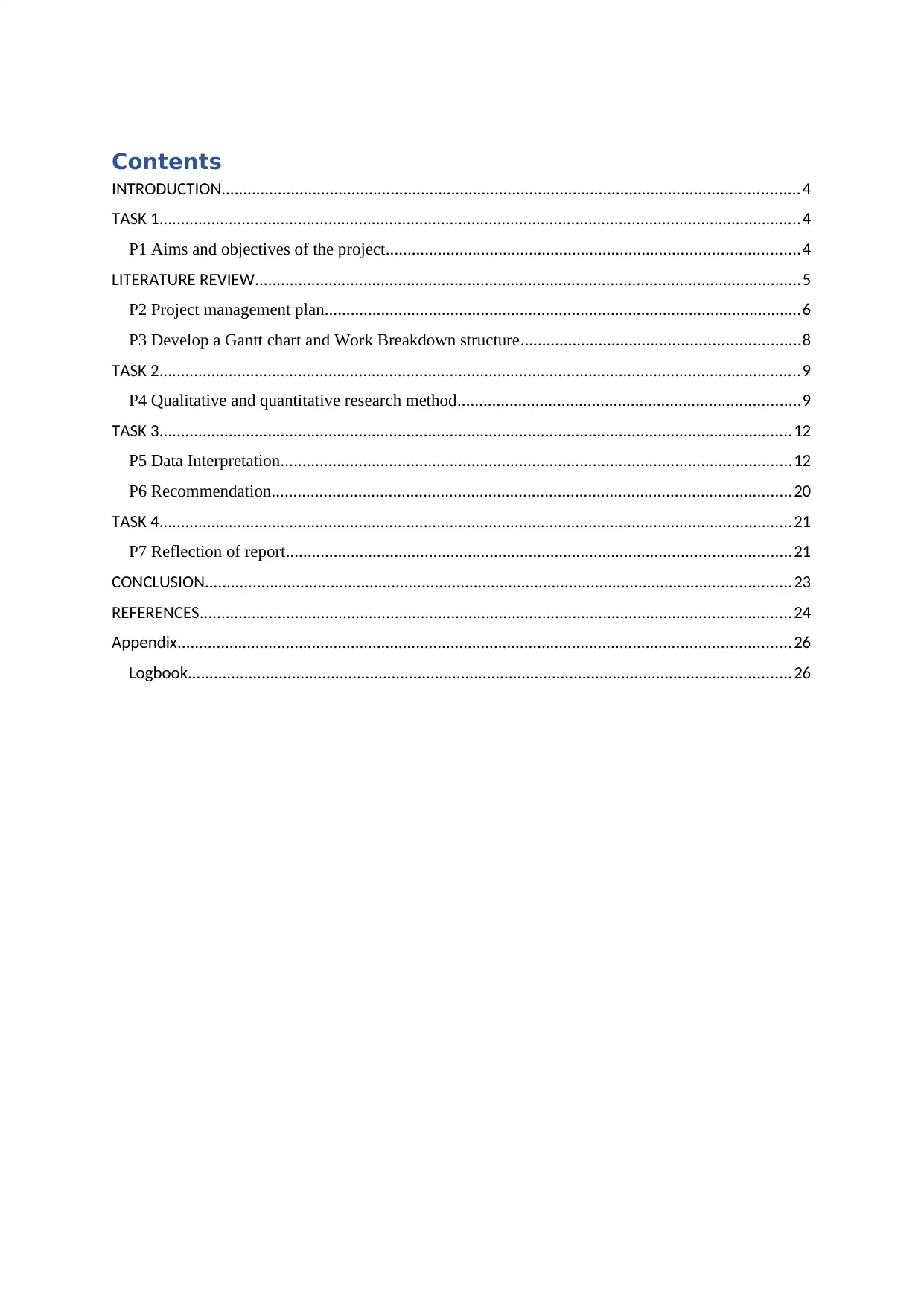
Contents
INTRODUCTION.....................................................................................................................................4
TASK 1....................................................................................................................................................4
P1 Aims and objectives of the project...............................................................................................4
LITERATURE REVIEW..............................................................................................................................5
P2 Project management plan..............................................................................................................6
P3 Develop a Gantt chart and Work Breakdown structure................................................................8
TASK 2....................................................................................................................................................9
P4 Qualitative and quantitative research method...............................................................................9
TASK 3..................................................................................................................................................12
P5 Data Interpretation......................................................................................................................12
P6 Recommendation........................................................................................................................20
TASK 4..................................................................................................................................................21
P7 Reflection of report....................................................................................................................21
CONCLUSION.......................................................................................................................................23
REFERENCES........................................................................................................................................24
Appendix.............................................................................................................................................26
Logbook...........................................................................................................................................26
INTRODUCTION.....................................................................................................................................4
TASK 1....................................................................................................................................................4
P1 Aims and objectives of the project...............................................................................................4
LITERATURE REVIEW..............................................................................................................................5
P2 Project management plan..............................................................................................................6
P3 Develop a Gantt chart and Work Breakdown structure................................................................8
TASK 2....................................................................................................................................................9
P4 Qualitative and quantitative research method...............................................................................9
TASK 3..................................................................................................................................................12
P5 Data Interpretation......................................................................................................................12
P6 Recommendation........................................................................................................................20
TASK 4..................................................................................................................................................21
P7 Reflection of report....................................................................................................................21
CONCLUSION.......................................................................................................................................23
REFERENCES........................................................................................................................................24
Appendix.............................................................................................................................................26
Logbook...........................................................................................................................................26
⊘ This is a preview!⊘
Do you want full access?
Subscribe today to unlock all pages.

Trusted by 1+ million students worldwide

Topic: “The types of Strategies and Initiatives companies put in place to build a diverse and
inclusive workforce”
INTRODUCTION
Inclusion and diversity is referred to a procedure which includes in the strategies and
initiatives with an objective of maximising working behaviour of employees so as to increase
their performance level as well as an organisation. Employees are considered as a valuable
asset whose contribution decides the growth and success of an organisation in competitive
market (Rumens, 2016). For this, it is important for the management to understand the
importance of inclusive and diverse workforce which can be possible through conducting a
research. For this, it is important to hire researcher who have sufficient knowledge and skills
to carry out an effective research. The present assignment report is based on Unilever which
is engaged in offering wide range of products such as food, energy drink, ice cream and
beverages and many more. Unilever owns more than 400 brands with having turnover of 53.7
billion euros in the year 2017. In the present research report, the management is hiring
researcher to identify the concept and importance of inclusive and diverse workforce. Along
with this, aims and objectives are framed, Project management plan, Literature review,
research methodology, data collection and analysis using different research methods
techniques, recommendations and valid conclusion at the end research.
TASK 1
P1 Aims and objectives of the project
Project aim:
The main aim of research project is “To analysis kinds of strategies and initiatives for
building diverse and inclusive workforce within an organisation. A case study on Unilever”.
Project objectives:
To understand the importance of diverse and inclusive workforce within an
organisation.
To identify the different kinds of strategies and initiatives implemented by Unilever
for building inclusive and diverse workforce at workplace.
To determine the challenges that can be faced by Unilever to build inclusive and
diverse workforce in working environment.
inclusive workforce”
INTRODUCTION
Inclusion and diversity is referred to a procedure which includes in the strategies and
initiatives with an objective of maximising working behaviour of employees so as to increase
their performance level as well as an organisation. Employees are considered as a valuable
asset whose contribution decides the growth and success of an organisation in competitive
market (Rumens, 2016). For this, it is important for the management to understand the
importance of inclusive and diverse workforce which can be possible through conducting a
research. For this, it is important to hire researcher who have sufficient knowledge and skills
to carry out an effective research. The present assignment report is based on Unilever which
is engaged in offering wide range of products such as food, energy drink, ice cream and
beverages and many more. Unilever owns more than 400 brands with having turnover of 53.7
billion euros in the year 2017. In the present research report, the management is hiring
researcher to identify the concept and importance of inclusive and diverse workforce. Along
with this, aims and objectives are framed, Project management plan, Literature review,
research methodology, data collection and analysis using different research methods
techniques, recommendations and valid conclusion at the end research.
TASK 1
P1 Aims and objectives of the project
Project aim:
The main aim of research project is “To analysis kinds of strategies and initiatives for
building diverse and inclusive workforce within an organisation. A case study on Unilever”.
Project objectives:
To understand the importance of diverse and inclusive workforce within an
organisation.
To identify the different kinds of strategies and initiatives implemented by Unilever
for building inclusive and diverse workforce at workplace.
To determine the challenges that can be faced by Unilever to build inclusive and
diverse workforce in working environment.
Paraphrase This Document
Need a fresh take? Get an instant paraphrase of this document with our AI Paraphraser
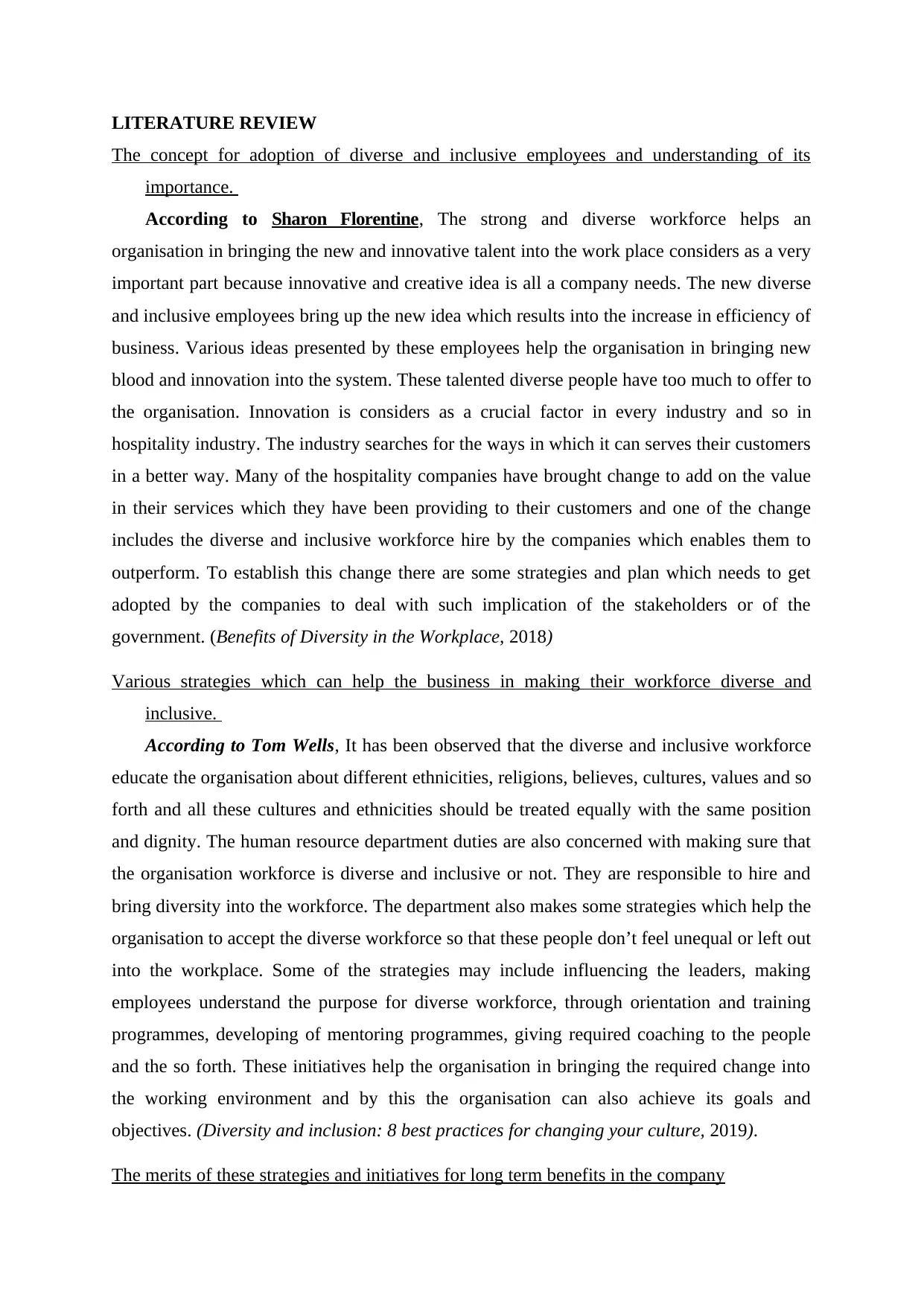
LITERATURE REVIEW
The concept for adoption of diverse and inclusive employees and understanding of its
importance.
According to Sharon Florentine, The strong and diverse workforce helps an
organisation in bringing the new and innovative talent into the work place considers as a very
important part because innovative and creative idea is all a company needs. The new diverse
and inclusive employees bring up the new idea which results into the increase in efficiency of
business. Various ideas presented by these employees help the organisation in bringing new
blood and innovation into the system. These talented diverse people have too much to offer to
the organisation. Innovation is considers as a crucial factor in every industry and so in
hospitality industry. The industry searches for the ways in which it can serves their customers
in a better way. Many of the hospitality companies have brought change to add on the value
in their services which they have been providing to their customers and one of the change
includes the diverse and inclusive workforce hire by the companies which enables them to
outperform. To establish this change there are some strategies and plan which needs to get
adopted by the companies to deal with such implication of the stakeholders or of the
government. (Benefits of Diversity in the Workplace, 2018)
Various strategies which can help the business in making their workforce diverse and
inclusive.
According to Tom Wells, It has been observed that the diverse and inclusive workforce
educate the organisation about different ethnicities, religions, believes, cultures, values and so
forth and all these cultures and ethnicities should be treated equally with the same position
and dignity. The human resource department duties are also concerned with making sure that
the organisation workforce is diverse and inclusive or not. They are responsible to hire and
bring diversity into the workforce. The department also makes some strategies which help the
organisation to accept the diverse workforce so that these people don’t feel unequal or left out
into the workplace. Some of the strategies may include influencing the leaders, making
employees understand the purpose for diverse workforce, through orientation and training
programmes, developing of mentoring programmes, giving required coaching to the people
and the so forth. These initiatives help the organisation in bringing the required change into
the working environment and by this the organisation can also achieve its goals and
objectives. (Diversity and inclusion: 8 best practices for changing your culture, 2019).
The merits of these strategies and initiatives for long term benefits in the company
The concept for adoption of diverse and inclusive employees and understanding of its
importance.
According to Sharon Florentine, The strong and diverse workforce helps an
organisation in bringing the new and innovative talent into the work place considers as a very
important part because innovative and creative idea is all a company needs. The new diverse
and inclusive employees bring up the new idea which results into the increase in efficiency of
business. Various ideas presented by these employees help the organisation in bringing new
blood and innovation into the system. These talented diverse people have too much to offer to
the organisation. Innovation is considers as a crucial factor in every industry and so in
hospitality industry. The industry searches for the ways in which it can serves their customers
in a better way. Many of the hospitality companies have brought change to add on the value
in their services which they have been providing to their customers and one of the change
includes the diverse and inclusive workforce hire by the companies which enables them to
outperform. To establish this change there are some strategies and plan which needs to get
adopted by the companies to deal with such implication of the stakeholders or of the
government. (Benefits of Diversity in the Workplace, 2018)
Various strategies which can help the business in making their workforce diverse and
inclusive.
According to Tom Wells, It has been observed that the diverse and inclusive workforce
educate the organisation about different ethnicities, religions, believes, cultures, values and so
forth and all these cultures and ethnicities should be treated equally with the same position
and dignity. The human resource department duties are also concerned with making sure that
the organisation workforce is diverse and inclusive or not. They are responsible to hire and
bring diversity into the workforce. The department also makes some strategies which help the
organisation to accept the diverse workforce so that these people don’t feel unequal or left out
into the workplace. Some of the strategies may include influencing the leaders, making
employees understand the purpose for diverse workforce, through orientation and training
programmes, developing of mentoring programmes, giving required coaching to the people
and the so forth. These initiatives help the organisation in bringing the required change into
the working environment and by this the organisation can also achieve its goals and
objectives. (Diversity and inclusion: 8 best practices for changing your culture, 2019).
The merits of these strategies and initiatives for long term benefits in the company
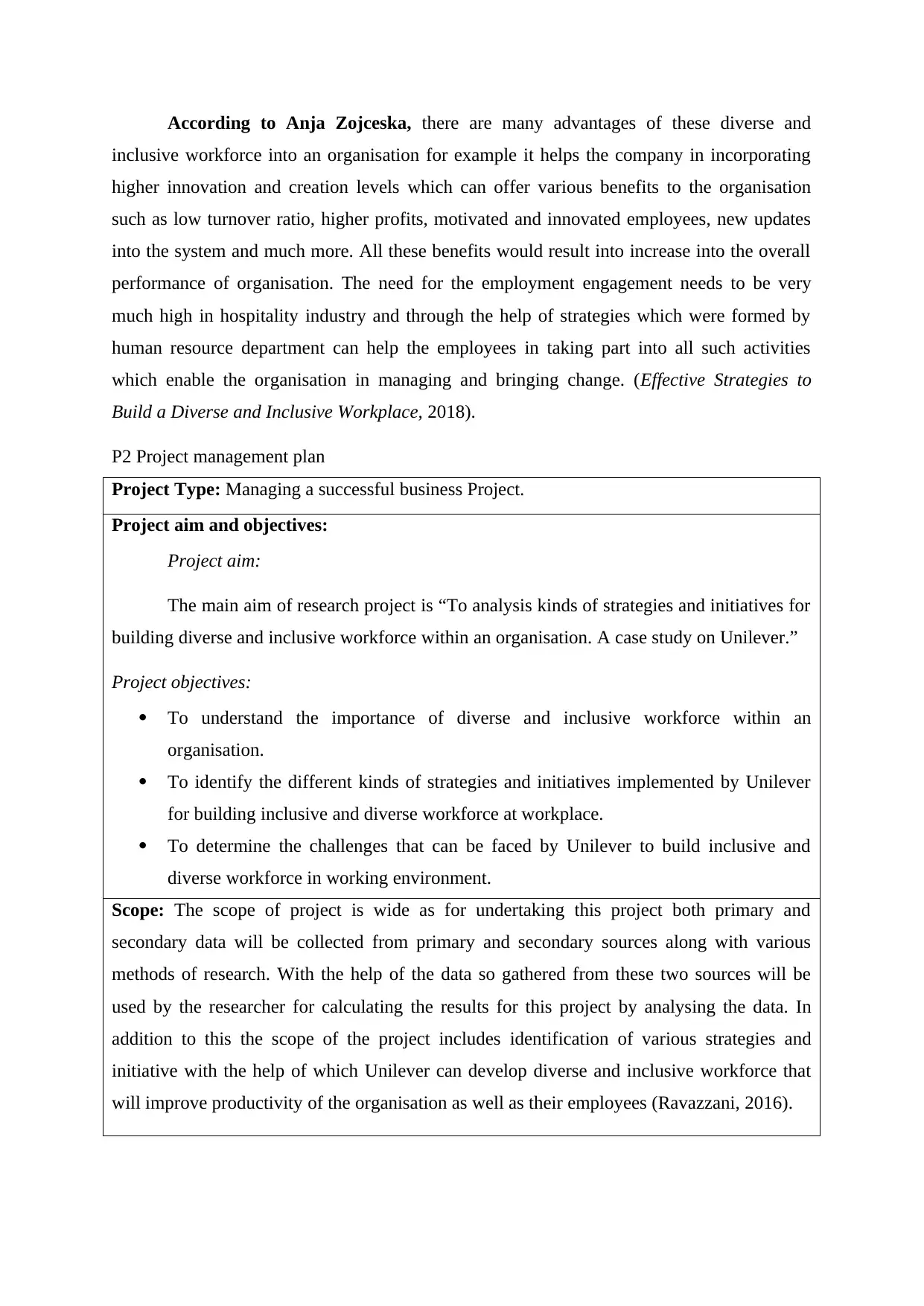
According to Anja Zojceska, there are many advantages of these diverse and
inclusive workforce into an organisation for example it helps the company in incorporating
higher innovation and creation levels which can offer various benefits to the organisation
such as low turnover ratio, higher profits, motivated and innovated employees, new updates
into the system and much more. All these benefits would result into increase into the overall
performance of organisation. The need for the employment engagement needs to be very
much high in hospitality industry and through the help of strategies which were formed by
human resource department can help the employees in taking part into all such activities
which enable the organisation in managing and bringing change. (Effective Strategies to
Build a Diverse and Inclusive Workplace, 2018).
P2 Project management plan
Project Type: Managing a successful business Project.
Project aim and objectives:
Project aim:
The main aim of research project is “To analysis kinds of strategies and initiatives for
building diverse and inclusive workforce within an organisation. A case study on Unilever.”
Project objectives:
To understand the importance of diverse and inclusive workforce within an
organisation.
To identify the different kinds of strategies and initiatives implemented by Unilever
for building inclusive and diverse workforce at workplace.
To determine the challenges that can be faced by Unilever to build inclusive and
diverse workforce in working environment.
Scope: The scope of project is wide as for undertaking this project both primary and
secondary data will be collected from primary and secondary sources along with various
methods of research. With the help of the data so gathered from these two sources will be
used by the researcher for calculating the results for this project by analysing the data. In
addition to this the scope of the project includes identification of various strategies and
initiative with the help of which Unilever can develop diverse and inclusive workforce that
will improve productivity of the organisation as well as their employees (Ravazzani, 2016).
inclusive workforce into an organisation for example it helps the company in incorporating
higher innovation and creation levels which can offer various benefits to the organisation
such as low turnover ratio, higher profits, motivated and innovated employees, new updates
into the system and much more. All these benefits would result into increase into the overall
performance of organisation. The need for the employment engagement needs to be very
much high in hospitality industry and through the help of strategies which were formed by
human resource department can help the employees in taking part into all such activities
which enable the organisation in managing and bringing change. (Effective Strategies to
Build a Diverse and Inclusive Workplace, 2018).
P2 Project management plan
Project Type: Managing a successful business Project.
Project aim and objectives:
Project aim:
The main aim of research project is “To analysis kinds of strategies and initiatives for
building diverse and inclusive workforce within an organisation. A case study on Unilever.”
Project objectives:
To understand the importance of diverse and inclusive workforce within an
organisation.
To identify the different kinds of strategies and initiatives implemented by Unilever
for building inclusive and diverse workforce at workplace.
To determine the challenges that can be faced by Unilever to build inclusive and
diverse workforce in working environment.
Scope: The scope of project is wide as for undertaking this project both primary and
secondary data will be collected from primary and secondary sources along with various
methods of research. With the help of the data so gathered from these two sources will be
used by the researcher for calculating the results for this project by analysing the data. In
addition to this the scope of the project includes identification of various strategies and
initiative with the help of which Unilever can develop diverse and inclusive workforce that
will improve productivity of the organisation as well as their employees (Ravazzani, 2016).
⊘ This is a preview!⊘
Do you want full access?
Subscribe today to unlock all pages.

Trusted by 1+ million students worldwide

Communication: While undertaking research it is important for the investigator to identify
various channel of communication with the help of which they can communicate with the
project manager of the company. The channels that can be used for communication by
researcher for this project are video conference, emails, consent form, telephonic
conversation etc.
Resources: For efficiently conducting the research various resources must be identified by
the research that can facilitate them in collecting the data and its analysis (Lindberg, 2016).
The resources that will be required for this research include funds, communication channels,
time etc. Apart from this, the researcher will require various resources of secondary sources
for data collection which includes books, journals, research papers etc.
Quality: It is important for the researcher to maintain the quality of the research that they are
undertaking and to ensure this they need to take into consideration the reliability and
accuracy of the sources from where they are gathering the information. For ensuring the
quality of the primary data it is important for the researcher to consider the responses directly
from the people who fall under the research. The quality of the project can also be managed
by taking into consideration the size of the organisation the nature of product that they are
offering because the strategies and initiative to be created will be dependent upon it. The
quality of data can also be ensured with the help of quality chart in which the specifications
are given on the basis of which the quality can be measured. Also the technique of
benchmarking can be used for setting standards of quality (Kirton, Robertson and Avdelidou‐
Fischer, 2016).
Cost: For conducting the research it is important for the researcher to estimate the cost that
they will incur as on the basis of this they procure funds and will allocate funds to different
activities. The estimation of cost can be done by the researcher by formulating budget and for
this research they will be required around 200 pound. While for implementing the strategies
and initiatives that are recommended by the researcher will include 700 pounds as they need
to organise various sessions for the employees.
Time: Time component defines the time limit within which the project has to be completed
by the investigator. For completing this project they will be required a period of 7 weeks in
which they will be conducting various activities related to the research. For ensuring the
timely completion of the project they will prepare Gantt chart so that time can be allocated to
different activities in which they have to be completed. With this they can manage their
various channel of communication with the help of which they can communicate with the
project manager of the company. The channels that can be used for communication by
researcher for this project are video conference, emails, consent form, telephonic
conversation etc.
Resources: For efficiently conducting the research various resources must be identified by
the research that can facilitate them in collecting the data and its analysis (Lindberg, 2016).
The resources that will be required for this research include funds, communication channels,
time etc. Apart from this, the researcher will require various resources of secondary sources
for data collection which includes books, journals, research papers etc.
Quality: It is important for the researcher to maintain the quality of the research that they are
undertaking and to ensure this they need to take into consideration the reliability and
accuracy of the sources from where they are gathering the information. For ensuring the
quality of the primary data it is important for the researcher to consider the responses directly
from the people who fall under the research. The quality of the project can also be managed
by taking into consideration the size of the organisation the nature of product that they are
offering because the strategies and initiative to be created will be dependent upon it. The
quality of data can also be ensured with the help of quality chart in which the specifications
are given on the basis of which the quality can be measured. Also the technique of
benchmarking can be used for setting standards of quality (Kirton, Robertson and Avdelidou‐
Fischer, 2016).
Cost: For conducting the research it is important for the researcher to estimate the cost that
they will incur as on the basis of this they procure funds and will allocate funds to different
activities. The estimation of cost can be done by the researcher by formulating budget and for
this research they will be required around 200 pound. While for implementing the strategies
and initiatives that are recommended by the researcher will include 700 pounds as they need
to organise various sessions for the employees.
Time: Time component defines the time limit within which the project has to be completed
by the investigator. For completing this project they will be required a period of 7 weeks in
which they will be conducting various activities related to the research. For ensuring the
timely completion of the project they will prepare Gantt chart so that time can be allocated to
different activities in which they have to be completed. With this they can manage their
Paraphrase This Document
Need a fresh take? Get an instant paraphrase of this document with our AI Paraphraser
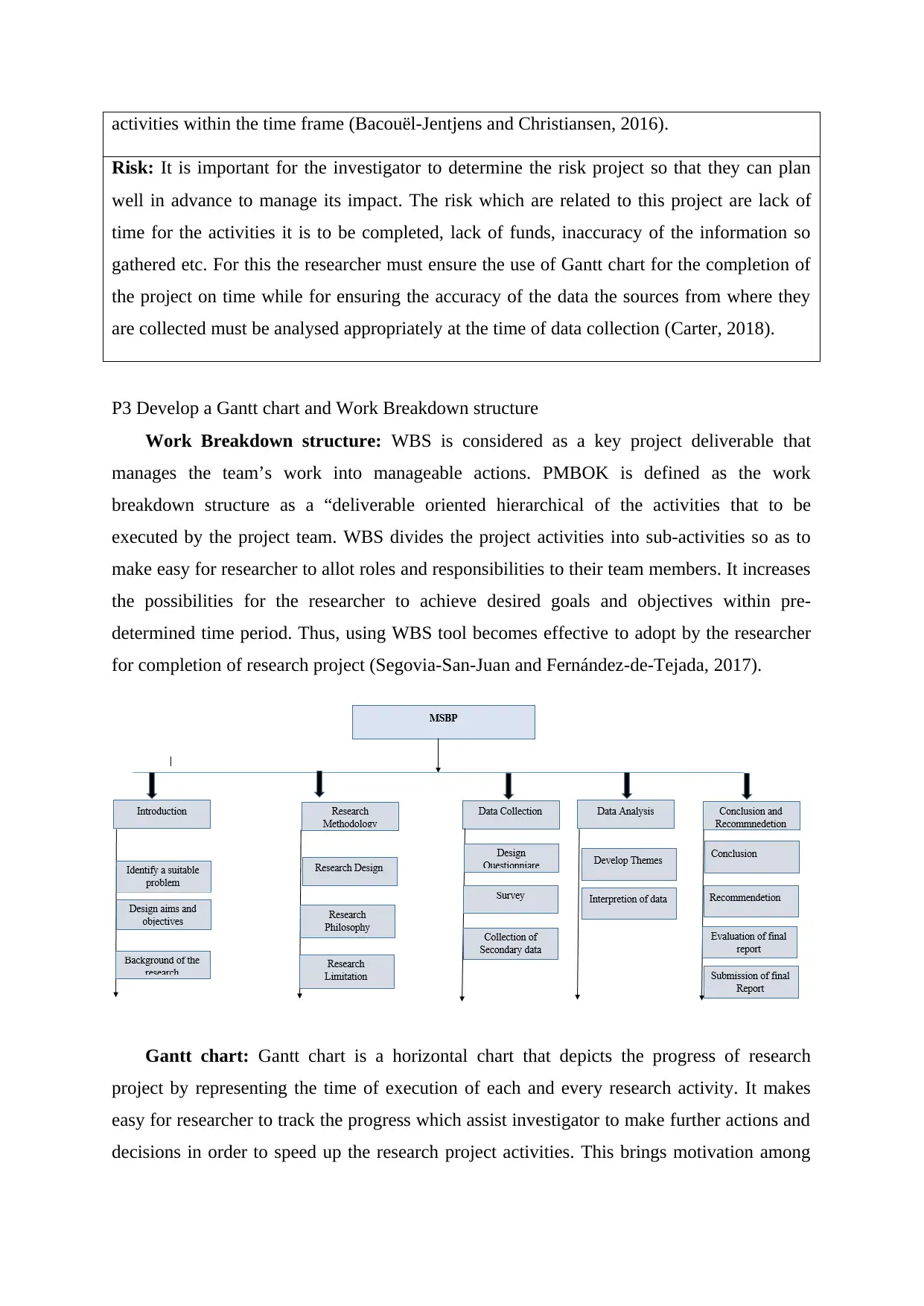
activities within the time frame (Bacouël-Jentjens and Christiansen, 2016).
Risk: It is important for the investigator to determine the risk project so that they can plan
well in advance to manage its impact. The risk which are related to this project are lack of
time for the activities it is to be completed, lack of funds, inaccuracy of the information so
gathered etc. For this the researcher must ensure the use of Gantt chart for the completion of
the project on time while for ensuring the accuracy of the data the sources from where they
are collected must be analysed appropriately at the time of data collection (Carter, 2018).
P3 Develop a Gantt chart and Work Breakdown structure
Work Breakdown structure: WBS is considered as a key project deliverable that
manages the team’s work into manageable actions. PMBOK is defined as the work
breakdown structure as a “deliverable oriented hierarchical of the activities that to be
executed by the project team. WBS divides the project activities into sub-activities so as to
make easy for researcher to allot roles and responsibilities to their team members. It increases
the possibilities for the researcher to achieve desired goals and objectives within pre-
determined time period. Thus, using WBS tool becomes effective to adopt by the researcher
for completion of research project (Segovia-San-Juan and Fernández-de-Tejada, 2017).
Gantt chart: Gantt chart is a horizontal chart that depicts the progress of research
project by representing the time of execution of each and every research activity. It makes
easy for researcher to track the progress which assist investigator to make further actions and
decisions in order to speed up the research project activities. This brings motivation among
Risk: It is important for the investigator to determine the risk project so that they can plan
well in advance to manage its impact. The risk which are related to this project are lack of
time for the activities it is to be completed, lack of funds, inaccuracy of the information so
gathered etc. For this the researcher must ensure the use of Gantt chart for the completion of
the project on time while for ensuring the accuracy of the data the sources from where they
are collected must be analysed appropriately at the time of data collection (Carter, 2018).
P3 Develop a Gantt chart and Work Breakdown structure
Work Breakdown structure: WBS is considered as a key project deliverable that
manages the team’s work into manageable actions. PMBOK is defined as the work
breakdown structure as a “deliverable oriented hierarchical of the activities that to be
executed by the project team. WBS divides the project activities into sub-activities so as to
make easy for researcher to allot roles and responsibilities to their team members. It increases
the possibilities for the researcher to achieve desired goals and objectives within pre-
determined time period. Thus, using WBS tool becomes effective to adopt by the researcher
for completion of research project (Segovia-San-Juan and Fernández-de-Tejada, 2017).
Gantt chart: Gantt chart is a horizontal chart that depicts the progress of research
project by representing the time of execution of each and every research activity. It makes
easy for researcher to track the progress which assist investigator to make further actions and
decisions in order to speed up the research project activities. This brings motivation among

team mates to work hard and contributes towards the completion the research project. This
makes easy for researcher to draw a valid conclusion at the end of research which further
communicate to their clients (Syed and Ozbilgin, 2019).
TASK 2
P4 Qualitative and quantitative research method
Research methodology is an important aspect that must be considered by researcher
while completion of research activities. It consists of various methods that must be taken into
consideration by the researcher which are described as below:
Quantitative method: It is a method which is used to measure the information which are
numeric in nature. It brings difficulties among researcher to represent the actual meaning of
gathered data by interpreting numerical information but once it can be understood by the
users then it kept with them for longer duration with facts and figures (Sharma and Mukherji,
2016).
Qualitative method: It is a method which is used to gather information by identifying
actual perceptions and opinions of people thus more difficult for the researcher to interpret
their actual emotions towards their clients but gives data with more reliability and accuracy.
Thus, it is considered as an effective method to adopt during progress of research work
(Ozturk and Tatli, 2016).
makes easy for researcher to draw a valid conclusion at the end of research which further
communicate to their clients (Syed and Ozbilgin, 2019).
TASK 2
P4 Qualitative and quantitative research method
Research methodology is an important aspect that must be considered by researcher
while completion of research activities. It consists of various methods that must be taken into
consideration by the researcher which are described as below:
Quantitative method: It is a method which is used to measure the information which are
numeric in nature. It brings difficulties among researcher to represent the actual meaning of
gathered data by interpreting numerical information but once it can be understood by the
users then it kept with them for longer duration with facts and figures (Sharma and Mukherji,
2016).
Qualitative method: It is a method which is used to gather information by identifying
actual perceptions and opinions of people thus more difficult for the researcher to interpret
their actual emotions towards their clients but gives data with more reliability and accuracy.
Thus, it is considered as an effective method to adopt during progress of research work
(Ozturk and Tatli, 2016).
⊘ This is a preview!⊘
Do you want full access?
Subscribe today to unlock all pages.

Trusted by 1+ million students worldwide
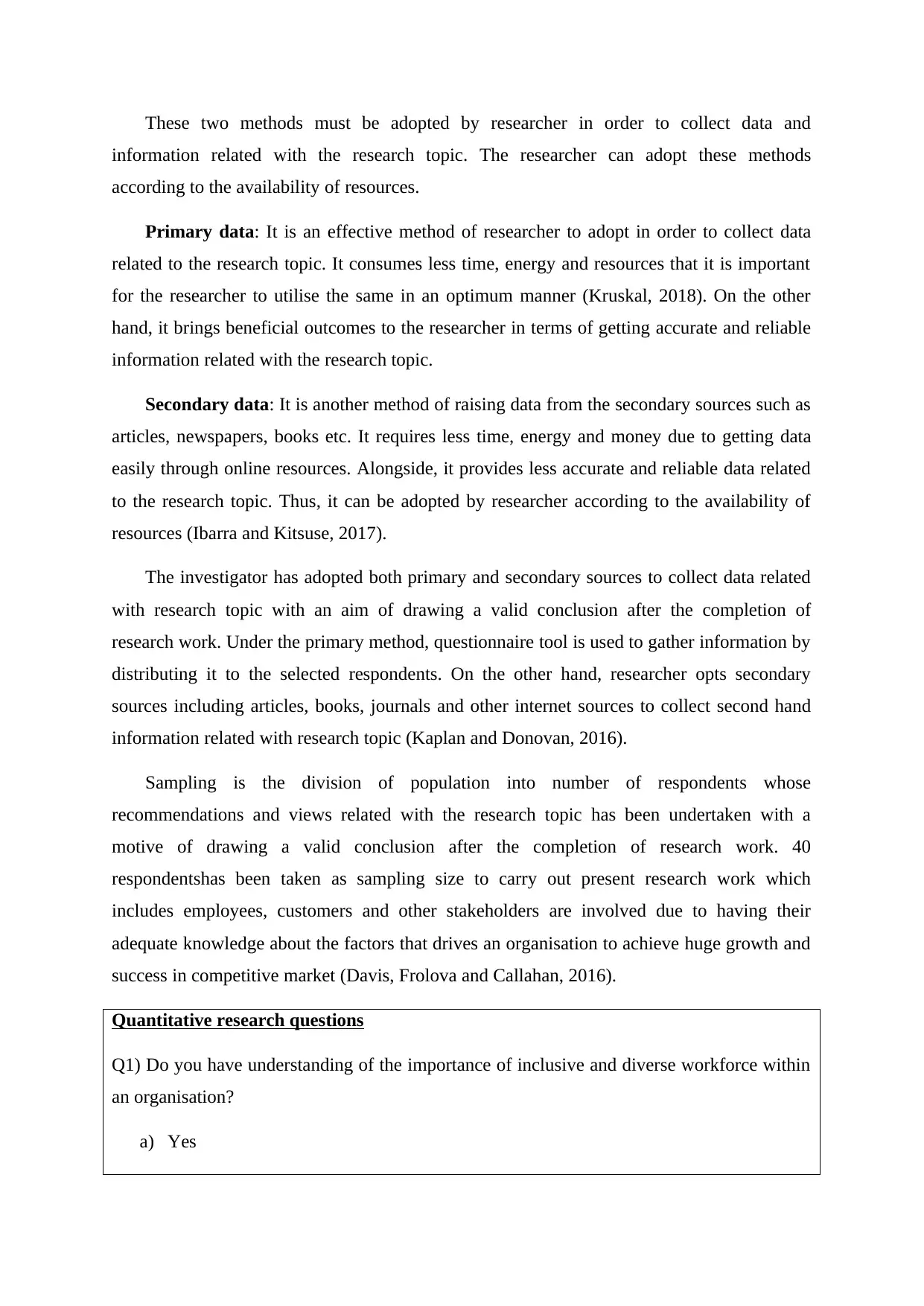
These two methods must be adopted by researcher in order to collect data and
information related with the research topic. The researcher can adopt these methods
according to the availability of resources.
Primary data: It is an effective method of researcher to adopt in order to collect data
related to the research topic. It consumes less time, energy and resources that it is important
for the researcher to utilise the same in an optimum manner (Kruskal, 2018). On the other
hand, it brings beneficial outcomes to the researcher in terms of getting accurate and reliable
information related with the research topic.
Secondary data: It is another method of raising data from the secondary sources such as
articles, newspapers, books etc. It requires less time, energy and money due to getting data
easily through online resources. Alongside, it provides less accurate and reliable data related
to the research topic. Thus, it can be adopted by researcher according to the availability of
resources (Ibarra and Kitsuse, 2017).
The investigator has adopted both primary and secondary sources to collect data related
with research topic with an aim of drawing a valid conclusion after the completion of
research work. Under the primary method, questionnaire tool is used to gather information by
distributing it to the selected respondents. On the other hand, researcher opts secondary
sources including articles, books, journals and other internet sources to collect second hand
information related with research topic (Kaplan and Donovan, 2016).
Sampling is the division of population into number of respondents whose
recommendations and views related with the research topic has been undertaken with a
motive of drawing a valid conclusion after the completion of research work. 40
respondentshas been taken as sampling size to carry out present research work which
includes employees, customers and other stakeholders are involved due to having their
adequate knowledge about the factors that drives an organisation to achieve huge growth and
success in competitive market (Davis, Frolova and Callahan, 2016).
Quantitative research questions
Q1) Do you have understanding of the importance of inclusive and diverse workforce within
an organisation?
a) Yes
information related with the research topic. The researcher can adopt these methods
according to the availability of resources.
Primary data: It is an effective method of researcher to adopt in order to collect data
related to the research topic. It consumes less time, energy and resources that it is important
for the researcher to utilise the same in an optimum manner (Kruskal, 2018). On the other
hand, it brings beneficial outcomes to the researcher in terms of getting accurate and reliable
information related with the research topic.
Secondary data: It is another method of raising data from the secondary sources such as
articles, newspapers, books etc. It requires less time, energy and money due to getting data
easily through online resources. Alongside, it provides less accurate and reliable data related
to the research topic. Thus, it can be adopted by researcher according to the availability of
resources (Ibarra and Kitsuse, 2017).
The investigator has adopted both primary and secondary sources to collect data related
with research topic with an aim of drawing a valid conclusion after the completion of
research work. Under the primary method, questionnaire tool is used to gather information by
distributing it to the selected respondents. On the other hand, researcher opts secondary
sources including articles, books, journals and other internet sources to collect second hand
information related with research topic (Kaplan and Donovan, 2016).
Sampling is the division of population into number of respondents whose
recommendations and views related with the research topic has been undertaken with a
motive of drawing a valid conclusion after the completion of research work. 40
respondentshas been taken as sampling size to carry out present research work which
includes employees, customers and other stakeholders are involved due to having their
adequate knowledge about the factors that drives an organisation to achieve huge growth and
success in competitive market (Davis, Frolova and Callahan, 2016).
Quantitative research questions
Q1) Do you have understanding of the importance of inclusive and diverse workforce within
an organisation?
a) Yes
Paraphrase This Document
Need a fresh take? Get an instant paraphrase of this document with our AI Paraphraser
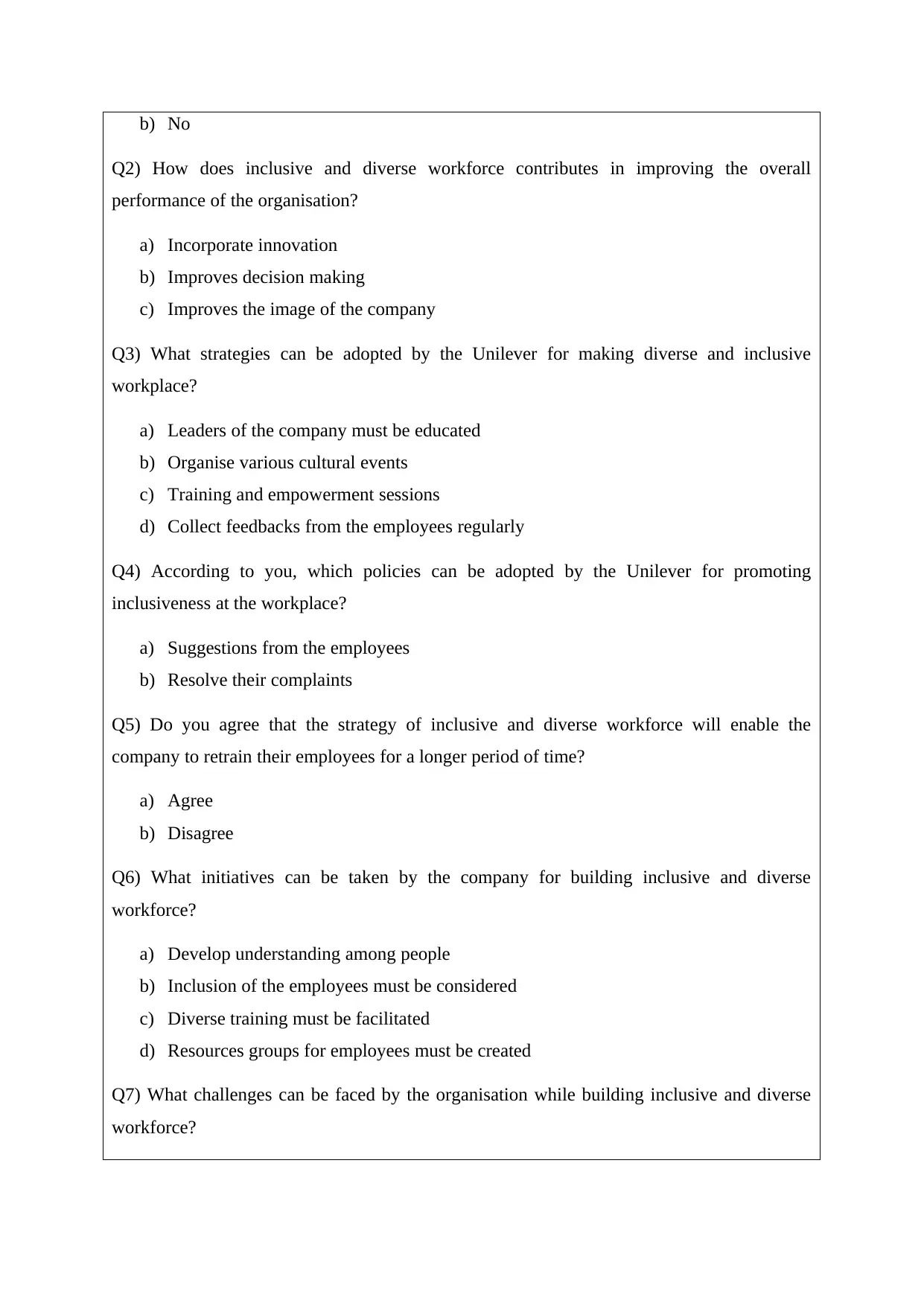
b) No
Q2) How does inclusive and diverse workforce contributes in improving the overall
performance of the organisation?
a) Incorporate innovation
b) Improves decision making
c) Improves the image of the company
Q3) What strategies can be adopted by the Unilever for making diverse and inclusive
workplace?
a) Leaders of the company must be educated
b) Organise various cultural events
c) Training and empowerment sessions
d) Collect feedbacks from the employees regularly
Q4) According to you, which policies can be adopted by the Unilever for promoting
inclusiveness at the workplace?
a) Suggestions from the employees
b) Resolve their complaints
Q5) Do you agree that the strategy of inclusive and diverse workforce will enable the
company to retrain their employees for a longer period of time?
a) Agree
b) Disagree
Q6) What initiatives can be taken by the company for building inclusive and diverse
workforce?
a) Develop understanding among people
b) Inclusion of the employees must be considered
c) Diverse training must be facilitated
d) Resources groups for employees must be created
Q7) What challenges can be faced by the organisation while building inclusive and diverse
workforce?
Q2) How does inclusive and diverse workforce contributes in improving the overall
performance of the organisation?
a) Incorporate innovation
b) Improves decision making
c) Improves the image of the company
Q3) What strategies can be adopted by the Unilever for making diverse and inclusive
workplace?
a) Leaders of the company must be educated
b) Organise various cultural events
c) Training and empowerment sessions
d) Collect feedbacks from the employees regularly
Q4) According to you, which policies can be adopted by the Unilever for promoting
inclusiveness at the workplace?
a) Suggestions from the employees
b) Resolve their complaints
Q5) Do you agree that the strategy of inclusive and diverse workforce will enable the
company to retrain their employees for a longer period of time?
a) Agree
b) Disagree
Q6) What initiatives can be taken by the company for building inclusive and diverse
workforce?
a) Develop understanding among people
b) Inclusion of the employees must be considered
c) Diverse training must be facilitated
d) Resources groups for employees must be created
Q7) What challenges can be faced by the organisation while building inclusive and diverse
workforce?
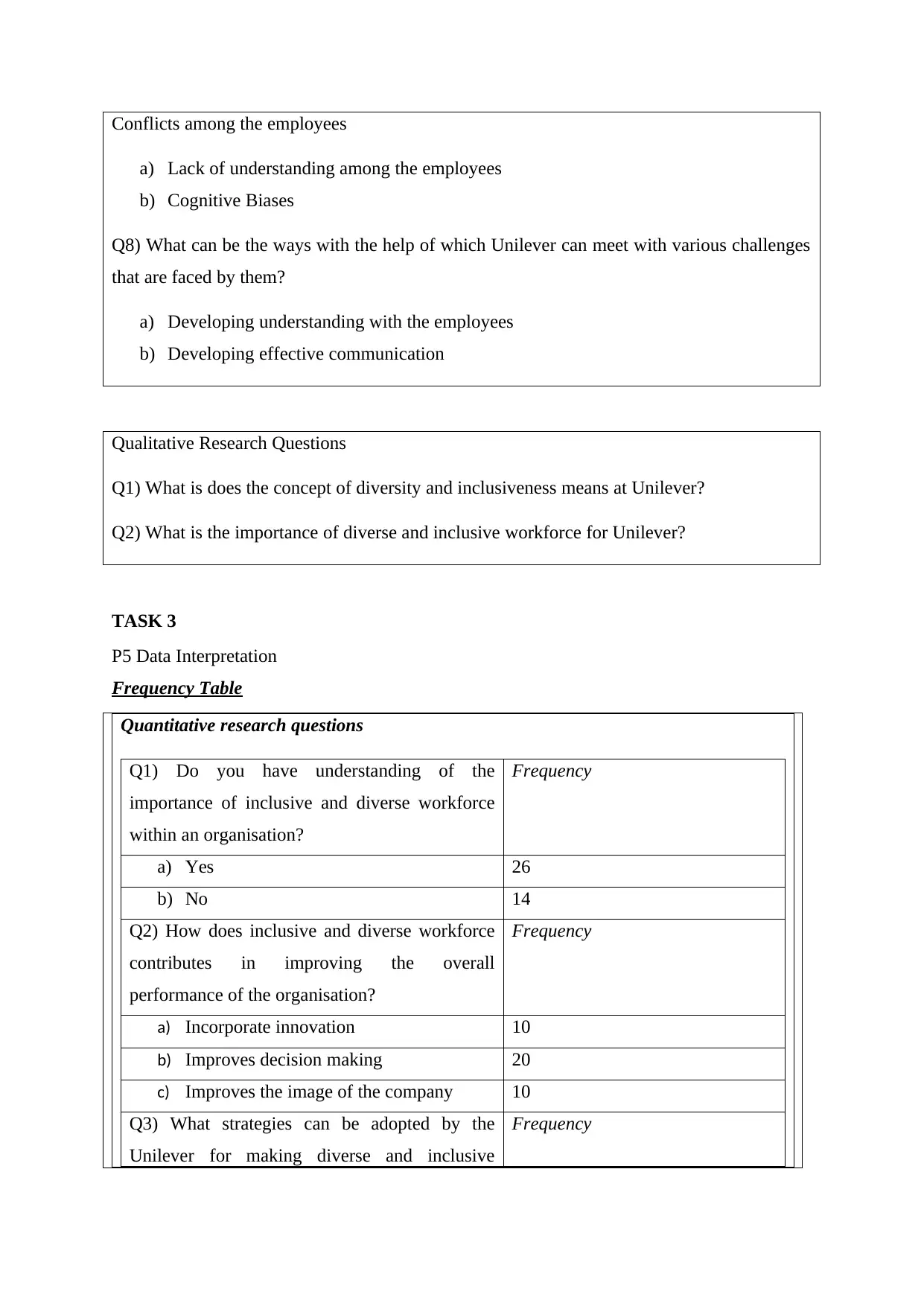
Conflicts among the employees
a) Lack of understanding among the employees
b) Cognitive Biases
Q8) What can be the ways with the help of which Unilever can meet with various challenges
that are faced by them?
a) Developing understanding with the employees
b) Developing effective communication
Qualitative Research Questions
Q1) What is does the concept of diversity and inclusiveness means at Unilever?
Q2) What is the importance of diverse and inclusive workforce for Unilever?
TASK 3
P5 Data Interpretation
Frequency Table
Quantitative research questions
Q1) Do you have understanding of the
importance of inclusive and diverse workforce
within an organisation?
Frequency
a) Yes 26
b) No 14
Q2) How does inclusive and diverse workforce
contributes in improving the overall
performance of the organisation?
Frequency
a) Incorporate innovation 10
b) Improves decision making 20
c) Improves the image of the company 10
Q3) What strategies can be adopted by the
Unilever for making diverse and inclusive
Frequency
a) Lack of understanding among the employees
b) Cognitive Biases
Q8) What can be the ways with the help of which Unilever can meet with various challenges
that are faced by them?
a) Developing understanding with the employees
b) Developing effective communication
Qualitative Research Questions
Q1) What is does the concept of diversity and inclusiveness means at Unilever?
Q2) What is the importance of diverse and inclusive workforce for Unilever?
TASK 3
P5 Data Interpretation
Frequency Table
Quantitative research questions
Q1) Do you have understanding of the
importance of inclusive and diverse workforce
within an organisation?
Frequency
a) Yes 26
b) No 14
Q2) How does inclusive and diverse workforce
contributes in improving the overall
performance of the organisation?
Frequency
a) Incorporate innovation 10
b) Improves decision making 20
c) Improves the image of the company 10
Q3) What strategies can be adopted by the
Unilever for making diverse and inclusive
Frequency
⊘ This is a preview!⊘
Do you want full access?
Subscribe today to unlock all pages.

Trusted by 1+ million students worldwide
1 out of 29
Related Documents
Your All-in-One AI-Powered Toolkit for Academic Success.
+13062052269
info@desklib.com
Available 24*7 on WhatsApp / Email
![[object Object]](/_next/static/media/star-bottom.7253800d.svg)
Unlock your academic potential
Copyright © 2020–2025 A2Z Services. All Rights Reserved. Developed and managed by ZUCOL.





